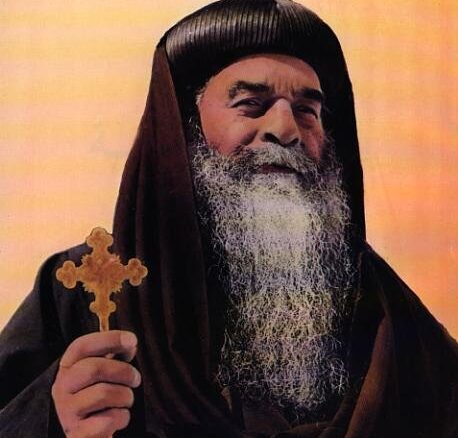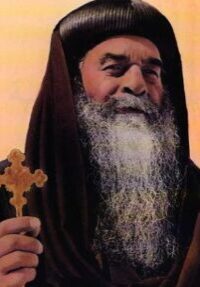Kyrillos VI
August 2, 1902 - March 9, 1971
Bishop of Alexandria
Bishop of Alexandria
From Damanhour, Egypt
Served in Cairo, Egypt
Affiliation: Coptic Orthodox
"The path leading to Heaven is both wide and narrow. It is wide because it can accommodate the worst sinners of this world. However, it is narrow because if you desire to walk in it you cannot bear to carry even one sin."
On March 9, the Coptic Orthodox Church remembers the departure of the Great Pope (Papa, Ava) Kyrillos (Cyril) VI, the 116th Pope of Alexandria and successor of Saint Mark the Evangelist. He sat on the throne of Saint Mark for twelve years (1959-1971). Pope Kyrillos was a holy man of prayer who through full dedication to the life of prayer and fasting possessed many higher gifts which included performing wonders and miracles, the gift of knowledge, and an unusual ability to lead by example. He was undoubtedly a very spiritual man and brought the Coptic Church into a new era of spirituality. He was highly regarded by the people of Egypt from all walks of life, Christians and non-Christians alike.
Pope Kyrillos VI was born on Saturday, August 2, 1902 and was called Azer Ata. His father Ata, was a church deacon and belonged to a middle class family. After completing high school, Azer went to work for a shipping company in Alexandria. Azer was content with little food and the ground to sleep on. Then much against his family’s wishes, he resigned his job with the intention of becoming a monk and entered the Monastery of El-Baramous on Wednesday, July 27, 1927. He was ordained monk on Saturday, February 25, 1928 and was named Mina after the name of Saint Mina (Menas or Mena), his patron saint. He was ordained priest on Saturday, July 18, 1931. He also attended the Helwan Theological College and was rated one of the top students.
Father Mina’s love for God was so great that he desired a life of solitude. Only thirty years old at the time, the monks refused his request saying, “You are only thirty years old and your monastic life is only five years. Do you want to pursue the life of solitude in the desert whereas many others before you have struggled for the same goal for thirty or forty years and failed?” The assembly of monks did not change Father Mina’s decision and he lived in a cave near the monastery. He pursued a life of solitude at El-Natron Valley in the western desert between Cairo and Alexandria, then he headed the Monastery of Saint Anba Samuel the Confessor at Zawarah in upper Egypt and devoted a great deal of effort toward the restoration of this historic landmark.
When the monastery of Saint Samuel was restored, he left that area and moved to a deserted windmill in El-Moukatam mountain at the outskirts of Cairo. This windmill was totally abandoned and very dangerous. It was miles from the nearest city. Many dangerous animals can be found there at all times, like scorpions and snakes. Here, Father Mina spent his time praying and contemplating because of his love for his Saviour.
It goes without saying that Father Mina had many obstacles to overcome which Satan setup. First Satan instigated the guard of Antiquities not to carry water to the monk. Afterward, God sent one of his saints in a dream to rebuke the guard. So he woke up and carried water to Father Mina who was in urgent need for it.
In another incident, Satan sent robbers to the windmill. The robbers beat Father Mina and injured his head. When Father Mina regained consciousness, he noticed he was bleeding. He crawled to the icon of Saint Mina and put the icon on his head. The bleeding stopped at once. Father Mina then went to the hospital to be treated. The doctors were surprised when they found out that he walked 15 miles from the windmill.
Father Mina also built a church at Ancient Cairo under the name of Saint Mina. He lived in this church till his ordination as Pope of Alexandria and the Holy See of Saint Mark in 1959. He found himself surrounded with college students, many of them were from outside Cairo, so he started a dormitory for students who needed this service. This informal program produced the first church-affiliated dormitory in modern times in Egypt, and produced many Church leaders, some of them became bishops and priests later on, e.g., the late bishop Samuel and His Holiness Pope Shenouda III (his successor), etc.
Father Mina used to clean the dormitory and the lavatories by himself without letting anybody know, and would not let anyone else do this job. By humiliating himself and serving others, he fulfilled our Lord’s commandment: “But it shall not be so among you: but whosoever will be great among you, let him be your minister; And whosoever will be chief among you, let him be your servant: Even as the Son of man came not to be ministered unto, but to minister, and to give his life a ransom for many” (Matthew 20:26).
The late Bishop Mina El-Samueli spent a few years of his monastic life with Father Mina. He recalled this story. He said, “Father Mina the Hermit used to wake up at 2:00 am, start the midnight Agpeya prayers, bake the ‘korban’, raise incense then serve the holy mass which would end around 8:00 am. This meant spending six continuous hours in prayer. Afterwards, he would meet with those who were hungry and thirsty for God’s mercy. Here is a sick person looking for a cure which he attains through the prayers of Father Mina. There is another facing a major decision in need of God’s guidance and obtains it through Father Mina’s advice. A third is tormented by a demon and is healed when Father Mina prays for him… Whoever sat with Father Mina obtained a definite relief, a heavenly relief. So one would leave knowing that his ship had found a true haven and his soul was filled with peace.”
One day Pope Kyrillos received a foreign priest in his private room at the old Cathedral of Saint Mark. The priest, seeing that the room of His Holiness was very humble and not to the standard a pope deserves, asked His Holiness to give him the permission to furnish the room and decorate it with the most luxurious furniture. The Pope laughed and thanked him for his love, saying: “The room in its current state is still much better than the manger where the Christ was born.” In his first papal letter, Pope Kyrillos said: “Let us disappear for God to appear with His blessed glory.”
This article is not our work. It can be found here.


